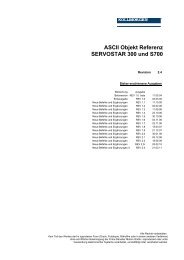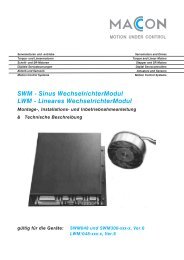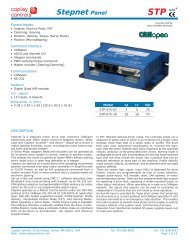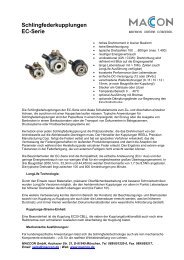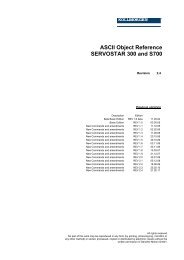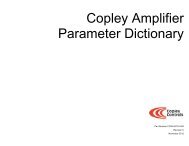CANopen Programmer's Manual - Maccon.de
CANopen Programmer's Manual - Maccon.de
CANopen Programmer's Manual - Maccon.de
You also want an ePaper? Increase the reach of your titles
YUMPU automatically turns print PDFs into web optimized ePapers that Google loves.
<strong>CANopen</strong> Programmer’s <strong>Manual</strong> 2: Network Management<br />
LIFE TIME FACTOR INDEX 0X100D<br />
Type Access Units Range Map PDO Memory<br />
Unsigned 8 RW - - NO R<br />
Description<br />
This object gives a multiple of the GUARD Time (in<strong>de</strong>x 0x100C, p. 46). The amplifier expects to<br />
receive a no<strong>de</strong>-guarding request within the time period <strong>de</strong>fined by the product of the guard time<br />
and the lifetime factor. If the amplifier has not received a no<strong>de</strong>-guarding request within this time<br />
period, it treats this condition as a fault.<br />
HIGH-RESOLUTION TIME STAMP INDEX 0X1013<br />
Type Access Units Range Map PDO Memory<br />
Unsigned 32 RW microseconds 0 - 294,967,295 YES R<br />
Description<br />
This object holds a time stamp indicating the amplifier's internal time (in microseconds) when the<br />
last SYNC message was received (or transmitted for the SYNC producer). Writing to this object<br />
will cause the amplifier to adjust its internal clocks to reconcile the difference between the value<br />
passed and the internal value of the time stamp.<br />
The purpose of this object is to allow multiple amplifiers to synchronize their clocks across the<br />
<strong>CANopen</strong> network. To enable this feature, one amplifier should be selected as a high-resolution<br />
time stamp producer. This amplifier should have a transmit PDO configured to transmit this object<br />
to the rest of the network at a rate of approximately 10 Hertz (once every 100 milliseconds).<br />
Every other amplifier should have a receive PDO configured (using the same COB-ID as the<br />
producer's transmit PDO) to update its time stamp using the value passed by the producer.<br />
PRODUCER HEARTBEAT TIME INDEX 0X1017<br />
Type Access Units Range Map PDO Memory<br />
Unsigned 16 RW milliseconds - NO R<br />
Description<br />
This object gives the frequency at which the amplifier will produce heartbeat messages. This<br />
object may be set to zero to disable heartbeat production. Note that only one of the two no<strong>de</strong>guarding<br />
methods may be used at once. If this object is non-zero, then the heartbeat protocol is<br />
used regardless of the settings of the no<strong>de</strong>-guarding time and lifetime factor.<br />
EMERGENCY OBJECT ID INDEX 0X1014<br />
Type Access Units Range Map PDO Memory<br />
Unsigned 32 RW - - NO R<br />
Description<br />
CAN message ID used with the emergency object. See Emergency Messages, p. 42 and the<br />
<strong>CANopen</strong> Application Layer and Communication Profile (DS 301).<br />
EMERGENCY OBJECT ID INHIBIT TIME INDEX 0X1015<br />
Type Access Units Range Map PDO Memory<br />
Unsigned 16 RW milliseconds - NO R<br />
Description<br />
Inhibit time for the emergency object. See Emergency Messages, p. 42 and the <strong>CANopen</strong><br />
Application Layer and Communication Profile (DS 301).<br />
Copley Controls 47




